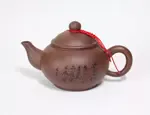Pouchong Tea
–
A Greener Oolong Tea
Pouchong tea is an oolong tea from Taiwan that is sweet, delicate and healthy. Large twisted dark green leaves are lightly oxidized to make this wonderful tea.
What makes this oolong tea so special?
This tea is so lightly oxidized that it is considered to be between green teas and other regular oolong teas and has the best of both worlds.
Sweet, mild, floral and fruity, this is a unique tea that grows on the hills of Taiwan. Rich in antioxidants, vitamins and minerals, you will receive a variety of benefits from a tea that requires no sweeteners.
Let’s have a tea together and enjoy the greenest of oolong teas!
What is Pouchong Tea?
Pouchong tea, or Bao Zhong in Mandarin, is an oolong tea that is mostly produced in Taiwan. Its name means "wrapped in paper" referring to its unique traditional processing method.
Made up of large dark green tea leaves with tiny white spots, twisted into a stick-like shape, this tea is also known as "flower tea" for its wonderfully fragrant floral smell.
How does it compare to green and oolong teas?
- This is Taiwanese is the least oxidized of all oolongs, with oxidation just reaching 8% to 12%, and so it is actually classified as being somewhere between a green and oolong tea.
- Pouchong tea lacks the sharp flavor typical of oolong teas, but it is also milder than most oolong teas. It combines the freshness of green tea and floral aromas of darker oolongs.
Origin of Pouchong Tea
It is said that this oolong tea was brought over from Fujian Province, in China, in the 19th century along with tea producing techniques. Today, most Pouchong oolong tea is produced in Taiwan and it is among the most popular and finest teas on the island.
Taiwan has the perfect climate to grow this tea: high temperatures and plenty of rainfall. This oolong tea is mainly produced in the Pinglin district near Taipei, in the Wenshan region (Wen Mountains), although it is still also produced in mainland China.
Processing Pouchong Tea
Harvesting begins as March draws to a close. Tea leaves are picked for a "spring tea", the most popular choice for this oolong tea, although summer, autumn and winter harvests also occur.
- Whole leaves are withered under the sun and indoors to release moisture from the leaves.
- Panning and rolling allows the short oxidation (8% to 12%) to take place. Rolling also allows for the tea leaves to take their twisted shape.
- Leaves are traditionally wrapped in white cotton paper for drying, which halts oxidation completely and removes final moisture from the tea leaf. Unlike other oolong teas, Pouchong tea is unroasted.
- Some tea producers like to use this particular type of tea to create scented teas, being jasmine and rose among the favorite scents.
Although more than one district or area in Taiwan may produce this particular tea, it is tea produced in the Wenshan district that is not only considered the most popular but also the best quality of all Pouchong teas.
Now let’s take a look at the components and benefits Pouchong oolong tea has to offer.
Pouchong Tea Benefits
This tea is rich in antioxidants, vitamins and minerals. It also contains caffeine and amino acids. All of these elements combined provide you with a list of benefits in each cup.
Improving Heart Health
- Drinking tea on a regular basis is said to help improve your cardiovascular health and to lower the risk of heart related diseases.
- This tea is rich in quercetin, a specific antioxidant compound that may help dilate the blood vessels, allowing blood to flow more easily.
- This tea, ingested on a regular basis, may also help lower cholesterol. All these efforts combined may reduce the risk of blood clots that lead to heart attacks and strokes.
Better Digestion and Weight Loss
- This type of tea may help to improve your digestion by boosting your metabolism. It helps to activate enzymes that break up food faster relieving indigestion and stomach pains.
- A healthy metabolism helps your body to get rid of unnecessary fat in food faster and thus helping you to reduce weight and fight obesity.
- Another positive aspect to Pouchong tea is its natural sweetness meaning that you don’t need to add sweeteners to it. This tea may also help control body sugar production joining in the effort to fight diabetes.
Stimulant and Relaxing Tea
- This Taiwanese oolong tea contains caffeine and therefore may act as a stimulant, helping you stay alert and improve your mental function.
- At the same time, this tea also contains an amino acid called L-theanine, which helps the mind to relax and calms the nerves. Combined with caffeine this will help you stay mentally focused without the jitteriness that caffeine in coffee may cause.
Immune System Booster
- The vitamin and antioxidant content in this tea may help to build your bodily defenses. A stronger immune system helps lower the risk of diseases caused by infections and inflammation.
- A good warm cup of tea when you feel sick may not only make you feel more comfortable, but it may also help speed your recovery time.
Improving Skin and Bones
- A daily cup of tea may have benefits that may be seen, too. Antioxidants in tea may keep your skin looking fresh, young and healthy, preventing signs of premature aging.
- Fluorine and calcium in tea may strengthen your teeth and bones. A cup of unsweetened tea may help prevent tooth decay and bad mouth odors.
Preventing Disease and Cancer
- Antioxidants in tea are being studied for their potential to reduce the risk of cancer. Although more scientific evidence is required, antioxidants in oolong tea may help free radicals caused by pollution and environmental stress.
- Free radicals are thought to cause damage at the cellular level, resulting in the growth and spreading of tumors in the body. Antioxidants found in tea, berries and cocoa are thought to help the body fight against these free radicals.
These benefits are common to many oolong teas. Find out more about these at oolong tea benefits.
Looking for this great floral oolong tea?
Caffeine in Pouchong Tea
This oolong tea from Taiwan has a moderate level of caffeine. This tea uses large tea leaves, which means that buds and small young shoots are usually not used to make Pouchong tea.
As most of the caffeine content is store in buds and shoots so that the tea plant may defend itself against insects and pest, large leaves have less of this stimulant. Still, if you are sensitive to caffeine be aware that there may be some unwanted side effects.
- Too much caffeine may cause headaches, nervousness, agitation and difficulty sleeping to the point of insomnia or heart palpitations.
- People allergic to caffeine may experience stomach problems or skin irritations. If you experience these symptoms, don’t drink any caffeinated beverages.
- Finally, if you are pregnant or breastfeeding, talk to your doctor about how much tea you may drink in your case, as caffeine may affect the fetus or nursing infant.
Caffeine in tea has its benefits, so enjoy it in moderation and in accordance with your specific bodily needs.
Drinking Pouchong Tea
Let’s learn how to brew Pouchong tea so that you may have the pleasure of enjoying the perfect cup of tea.
Quantity: 1-2tsp/cup (250ml)
Steeping Time: 2-5 minutes
Rebrew allowed: Yes
Milk: No
Sweetener: No
Best paired with: dried fruits or milky deserts
Tea Ware
- This oolong tea is best brewed in a small clay teapot, but if you don’t own one, choose a nice porcelain teapot. As for cups, white tea cups are the best for you to enjoy the color of your tea.
- Preheat both the teapot and cups by swirling hot water inside and then tossing it away. This step will help ensure your tea does not cool down too quickly.
The Tea
- Place 1 to 2 teaspoons of Pouchong tea per cup inside the teapot. This is the usual recommendation for western-style tea brewing, but you may increase or decrease the amount of tea leaves for a stronger or weaker tea.
- For the Gongfu cha method, use a small Yixing teapot and fill it 1/4 to 1/3 with tea leaves.
The Water
- Heat water to 90ºC – 95ºC (194ºF -203ºF) and pour over the tea leaves. This oolong tea is more delicate than other oolongs, so using boiling water may not be the best idea.
Steeping
- Some brands recommend steeping this tea for 1 minute or less, some will recommend longer times, somewhere between 5 to 7 minutes.
- For western-style brewing, brew for about 2 to 5 minutes. Less time will give a milder tea whereas longer brewing time will give you a stronger tea. Adjust to your liking. Then add 30 seconds for each additional brew.
- For the Chinese Gongfu way, brew your tea for about 45 seconds to 1 minute and then add about 10 to 15 seconds to each additional infusion.
Drinking
- Once steeping is done pour the tea into the cups emptying the whole teapot. This will stop the infusion and let you reuse these leaves sometimes up to 6 times.
- The infused tea has a nice straw yellow color, with hints of light green, which becomes more and more amber with each reinfusion.
- Take sip of your Pouchong tea and feel its mellow floral fresh flavor. It is smooth and has with a naturally sweet, fruity melon-like, aftertaste. Feel its wonderfully delicate and floral fragrance as you savor each cup of tea.
This tea is said to be milder than other oolong teas, but stronger than the typical green tea. This is a great desert tea to be drunk with milky desserts or dried fruits or as an afternoon tea.
Enjoy a unique oolong tea from Taiwan, a nice sweet tea that will complement perfectly with afternoon treats.
Try Pouchong tea today!
Return from Pouchong Tea to Types of Tea
Return to The Right Tea Homepage
”In the Taste of a single cup of tea you will eventually discover the truth of all the ten thousand forms in the universe.”
- Attributed to Kyongbong Sunim, Ch'an (Zen) Master

Do you have a question? Then feel free to Contact Us!
And don’t forget to follow us on Facebook to receive updates, photos and interesting tips and news! Follow us also on Pinterest!
Search Website:
Be healthy
with a wide
choice of herbs!

Prepare your tea!
Try these
Tea Samplers!

Wellness Pack at ArtofTea.com

Award Winning Pack ar ArtofTea.com
Find other
tea time items at ...










